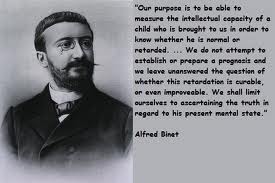
Alfred Binet was born in Nice, France, on July 8, 1857. He went to Paris to study law, and began a career in law. Around 1878, Binet found himself grippedby the studies of hypnosis performed by Jean Charcot, a French neurologist working at Salpetriere Hospital in Paris. Charcot's work inspired Binet to abandon his law career and enter into further study of medicine and science. Ultimately, he earned a doctorate in natural science, and began work as a research associate in a laboratory at the Sorbonne in 1891. Binet rose through theranks to become assistant director in 1892, and then director in 1895. He remained director of this Laboratory of Physiological Psychology of the Ecole Pratique Des Hautes Etudes for the rest of his life (from 1895-1911).
Binet's first work was on hypnosis and hysteria, the topics of his mentor, Charcot. Later, he began branching out into studies of subconscious thought, personality, and experimental psychology. Binet's publications from this time period included La Psychologie du Raisonnement (The Psychology of Reason, 1886); Le Magnetisme Animal (Animal Magnetism, 1887);and On Double Consciousness (1889).
Bored by the prevailing German research of this time period, which primarilystudied sensation and perception, Binet found himself captivated by the studyof higher reasoning. He explored ways to measure such higher mental functions, attempting to do so utilizing paper, pencil, pictures, inkblots, and otherportable objects.
In 1895, Binet founded a laboratory at the Ecole de la Rue de la Grange aux Belles. Here he established his study of the development of intelligence by examining his own young daughters, Armande and Margeurite. In 1903, he published L'Etude Experimentale de l'Intelligence ("The Experimental Study ofIntelligence"), a well-respected work utilizing data from his work with his daughters. Also in 1895, Binet founded an annual publication called L'AnneePsychologique. Much of Binet's work was published in this journal, and he received much acclaim for his innovative methodology. His work included studies of emotion, memory, attention, and problem solving.
Binet became interested in Sir Francis Galton, an English psychologist who was attempting to quantify individual cognitive capacity by administering standardized tests. Binet used Galton's work to examine a variety of famous and brilliant personalities, including writers, artists, mathematicians, and chessplayers. In 1892, Binet published Les alterations de la Personnalite (Alterations of Personality), co-authored with C. Fere.
In his study of children's intelligence, Binet compared and contrasted the development of gifted children and retarded (developmentally delayed) children.He attempted to find ways to predict intelligence, examining such parametersas body measurements and handwriting. Binet's study of this area was greatlyadvanced when the French government approached him in 1904, asking him to make recommendations for the education of children of lesser intellectual capacity. This prompted Binet to renew his efforts to create a diagnostic tool which could quantify an individual child's intellectual ability, in order to place children in classes appropriate to their cognitive abilities. Binet workedon this tool with Theodore Simon, completing the first version in 1905. ThisBinet-Simon scale was intended to test a child's cognitive capacity, not hisor her learned knowledge.
The Binet scale involved testing children on a variety of tasks, especially abstract problem solving, which Binet and Simon determined to be conquered bythe majority of children by a particular average age. Binet and Simon testedmany, many Parisian school children to determine what problem solving tasks could be expected to be mastered by a given age. Test scores were then reported as a mental age, ranging from 3-13 years. A child's mental age might matchhis or her chronological age if he or she were perfectly on target for age, or it might differ in either direction from his or her chronological age. A mental age lower than chronological age may indicate mental retardation; a mental age greater than chronological age might indicated giftedness. The scale was also intended to give the tester an indication of other school readiness issues, including social responsibility, self-care, and complexity of play behavior.
In addition to further revisions of the Binet-Simon scale, Binet also published Les Enfants Anormaux with Simon (Abnormal Children, 1907); as well as Les Idees Moderne Sur les Enfants (Modern Ideas about Children, 1909). In 1911, Binet died while he was in the process of creatinga revised and updated version of the Binet-Simon scale.
The Binet-Simon Scale became known worldwide as a valid and valuable diagnostic tool. In 1908 and 1911, it was revised by Henry H. Goddard in Vineland, New Jersey for American usage. In 1916, Lewis M. Terman of Stanford Universityfurther revised the tool for use in the United States. For decades, this Stanford-Binet test was the most commonly utilized intelligence test throughout the United States.





0 comments:
Post a Comment